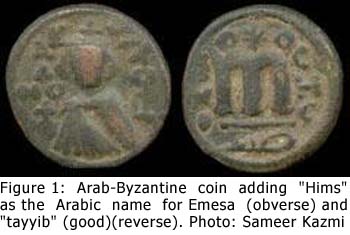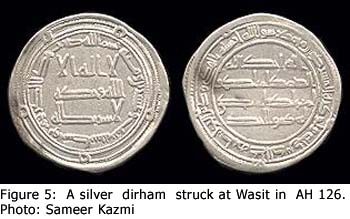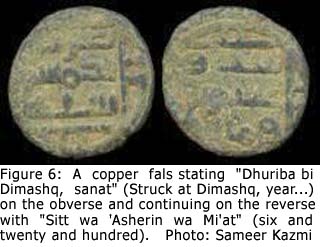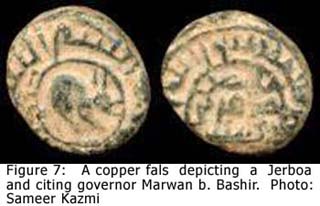At the advent of Islam, Arabia for the most part had a very limited numismatic history of its own. The past local coinage seems to be limited to that of the Sabaeans, the Himyarites, the Nabataens, and Rome's Provencia Arabia. However, by Muhammad's birth, these were already centuries old.
It is generally agreed that in the 7th century CE, Arabia was mostly still a trade-barter society. What little need the local populace had of coinage was sufficiently fulfilled by the then current coinage of the Byzantine and Sassanian Empires.
Even after establishing the first Islamic state in CE 622, the Muslims did not institute a coinage of their own. This remained true for Arabia through the end of the Orthodox Caliphate and the early part of the Umayyad rule.
As the Arabs spread out and conquered the surrounding lands, all that they really brought with them was the message of Islam. In most cases, the local political and economic infrastructure was left intact. As long as the non-Muslims of the conquered lands paid a Poll-Tax, not much had to be changed.
 The conquered lands of the Byzantine and Sassanian realms had a rich numismatic history, however, and the use of officially minted coinage had an important place in commerce. To maintain the economic viability, the Arabs continued the previously existing minting operations there - issuing coins from captured Byzantine and Sassanian dies, and then slowly adding new elements to the replacement dies. The first changes were subtle; adding "tayyib" (good) in the recently evolved Kufic script on Byzantine style copper coinage, or short and simple religious statements such as "Bismillah" (with the Name of Allah) on the margins of Sassanian coinage. The conquered lands of the Byzantine and Sassanian realms had a rich numismatic history, however, and the use of officially minted coinage had an important place in commerce. To maintain the economic viability, the Arabs continued the previously existing minting operations there - issuing coins from captured Byzantine and Sassanian dies, and then slowly adding new elements to the replacement dies. The first changes were subtle; adding "tayyib" (good) in the recently evolved Kufic script on Byzantine style copper coinage, or short and simple religious statements such as "Bismillah" (with the Name of Allah) on the margins of Sassanian coinage.
These changes further evolved as the mint names were duplicated in Arabic in the western lands and the governors added their name on coins in the east. Islamic coinage evolving from these styles are today called Arab-Byzantine or Arab-Sassanian coins, based on the originally borrowed style.
 Examples of these early coins can be seen in: Examples of these early coins can be seen in:
- Figure 1 Arab-Byzantine coin adding "Hims" as the Arabic name for Emesa (obverse) and "tayyib" (good) (reverse).
- Figure 2 Arab-Byzantine coin from Tiberias, "Tabariyya" written in Arabic.
- Figure 4 Arab-Sassanian coin citing governor 'Ubaydullah b. Ziyad, minted in Basrah, AH 60, with "Bismillah" in the obverse margin.
These types continued to evolve with additional religious slogans and Kufic inscription on both types of coins until the time of Umayyad Caliph 'Abd al-Malik b. Marwan.
 Around AH 70 (CE 690) a dispute arose when the Byzantines refused to accept Egyptian papyrus bearing Islamic slogans on the "mark of authenticity" supplied by the Arabs. 'Abd al-Malik retaliated by issuing the first Islamic gold coins replacing the cross with a bar/pole, sometimes with the angles of the cross turned into a circle, and adding the "Kalima" - Islamic declaration of Faith. Around AH 70 (CE 690) a dispute arose when the Byzantines refused to accept Egyptian papyrus bearing Islamic slogans on the "mark of authenticity" supplied by the Arabs. 'Abd al-Malik retaliated by issuing the first Islamic gold coins replacing the cross with a bar/pole, sometimes with the angles of the cross turned into a circle, and adding the "Kalima" - Islamic declaration of Faith.
This resulted in a back-and-forth of "threatening" coin types including the type where the Caliph is portrayed in a defiant stance with his hand on a sword (figure 3).
 By the year AH 74, prototypes were being struck at a few mints to define Islam's own coinage. However, most were still based on the earlier types with changes in the iconography and inscriptions. Probably, the most interesting of these "test" coins are the experimental silver pieces minted in the east where the Sassanian "Fire Altar" on the reverse was replaced by "Caliph in Worship" or "Three Standing Worshippers". By the year AH 74, prototypes were being struck at a few mints to define Islam's own coinage. However, most were still based on the earlier types with changes in the iconography and inscriptions. Probably, the most interesting of these "test" coins are the experimental silver pieces minted in the east where the Sassanian "Fire Altar" on the reverse was replaced by "Caliph in Worship" or "Three Standing Worshippers".
At the same time non-pictoral, purely inscription types were also being designed and considered. It is commonly believed that 'Abd al-Malik preferred the inscriptional type to the iconographic types on a recommendation from al-Hajjaj b. Yusuf. However, some Muslim scholars disagree, instead crediting Muhammad al-Baqir b. 'Ali b. al-Hussayn - a great-great-grandson of The Prophet with influencing the change.
In AH 77, 'Abd al-Malik introduced his monetary reforms by issuing gold dinars with the Kalima with "The Mission Statement" (adapted from al-Qur'an IX:33) on the obverse and al-Ikhlas (al-Qur'an CXII) with the year of mintage on the reverse.
 It is not clear exactly when, but by AH 79 silver dirhams were added for mass production. Similar to the the dinars, these had the Kalima on the obverse and al-Ikhlas on the reverse. The mission statement, however, was now placed on the reverse and the date, along with the added mint name, was moved to the obverse. It is not clear exactly when, but by AH 79 silver dirhams were added for mass production. Similar to the the dinars, these had the Kalima on the obverse and al-Ikhlas on the reverse. The mission statement, however, was now placed on the reverse and the date, along with the added mint name, was moved to the obverse.
- Figure 5 depicts a silver dirham struck at Wasit in Ah 126.
A reform type copper coinage was also introduced, presumably between AH 74 & AH 79. However, the design was not standardized, seemingly leaving it in the hands of civic authorities. Some of them continued to use various pictoral elements, and the weight was based on local needs.
To illustrate:
 - Figure 6 is a copper fals stating "Dhuriba bi Dimashq, sanat" (Struck at Dimashq, year...) on the obverse and continuing on the reverse with "Sitt wa 'Asherin wa Mi'at" (six and twenty and hundred). - Figure 6 is a copper fals stating "Dhuriba bi Dimashq, sanat" (Struck at Dimashq, year...) on the obverse and continuing on the reverse with "Sitt wa 'Asherin wa Mi'at" (six and twenty and hundred).
- Figure 7 is a copper fals depicting a Jerboa and citing governor Marwan b. Bashir.
- Figure 8 is an Umayyad copper fals from Egypt weighing "18 qirats".
With limited exceptions, these coin types became the proto-type for future Islamic coinage for over 200 years and influenced some on Islamic coinage for another thousand years.


|